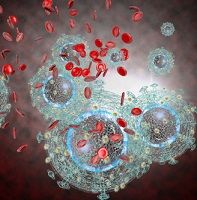Article
Treating HIV-1 Subtype C
Author(s):
As new HIV strains gain ground, it is important to keep testing which antivirals will work to halt them. A study focused on HIV-1 subtype C infection.

 As new HIV strains gain ground, researchers know it is important to keep testing which antivirals will work to halt them.Â
Scientists using mathematical modeling have characterized viral decay dynamics and estimated the within-host basic reproductive ratio (R0) of the human immunodeficiency virus 1 (HIV-1) subtype C infection.
The study, conducted by Anita Shet, MD, of the Department of Pediatrics in the Division of Infectious Diseases at St. John’s Medical College Hospital in Bangalore, India, and colleagues, was published in the Journal of Acquired Immune Deficiency Syndromes recently.
Â
The authors begin by stating “early studies on mathematical modeling of viral load changes after ART [antiretroviral therapy] initiation†made some of the greatest advances in treating HIV possible. “Much of this knowledge,†they go on to say, “has been gleaned from studies on patients with HIV-1 subtype B (HIV-1B) infection.â€
However, 48% of HIV cases globally now are HIV-1 subtype C (HIV-1C), and the researchers wonder, “whether knowledge gleaned from studies of HIV-1B infection can be applied to HIV-1C infection.â€
Â
“We undertook this study with the aim of determining viral dynamics in HIV-1C-infected individuals initiating first-line ART in India,†the authors say. They used mathematical modeling to determine R0, saying that R0 is “a measure of the ability of a virus to establish lasting infection among host cells and quantifies the infective and replicative fitness of the viral strain.†When R0 is less than 1 the virus cannot survive.
Â
The researchers say, “Between 2010 and 2011, 257 individuals with HIV-1C infection initiated ART at the Infectious Diseases Clinic at St. John’s Medical College and were followed for the first 6 months of treatment or longer.†Of those, 56% achieved a viral load of less than 150 copies per milliliter after three months of ART, and 87.5% after six months.
Â
“The key finding is a smaller within-host basic reproductive ratio, R0, compared with HIV-1B, predicting better treatment outcomes for HIV-1C infection,†report the researchers. They found that HIV-1C is less fit than HIV-1B, however, they say, “An intriguing question that follows is how HIV-1C infection is associated with higher set-point viral loads despite its lower fitness compared with HIV-1B infection.â€
Â
The authors conclude by saying that this study shows HIV-1C may be evolving to be more transmissible but less virulent than HIV-1B. “Unraveling the molecular underpinnings of this intriguing evolutionary possibility may provide crucial insights into virus-host interactions and the global epidemiology of infections diseases,†they conclude.
Â
Related Coverage:Â
The Most Dominant HIV Subtype Is Also the Weakest
Baby Boomers’ Behavior Adds to HIV Risk
Dormant HIV Proviruses Pose a Problem for Accurate Viral Count





